
Earlier in the week I asked my friend Gary Shilling if he could give me a summary of his 2016 forecast. He agreed to do so and sent it on. Then this morning he sent out a special short report on China that offers what I think is a valuable perspective that differs from what we’re seeing in the headlines – John Mauldin
The current turmoil in the Chinese economy and financial markets is shaking security markets globally as the yuan nosedived in the first week of this year and Chinese equities lost $1.1 trillion. What a contrast to the 13.3% compound annual growth from 1992 through 2007 (Chart 1) that propelled China’s GDP from 9% of America’s total to 59% last year (Chart 2)! So China moved ahead of Japan in 2009 to become the world’s second-largest economy as hundreds of millions of Chinese rose from poverty.
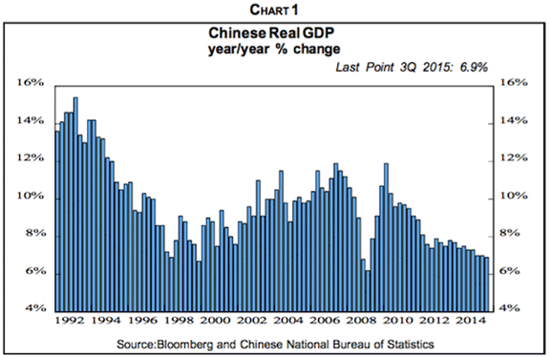
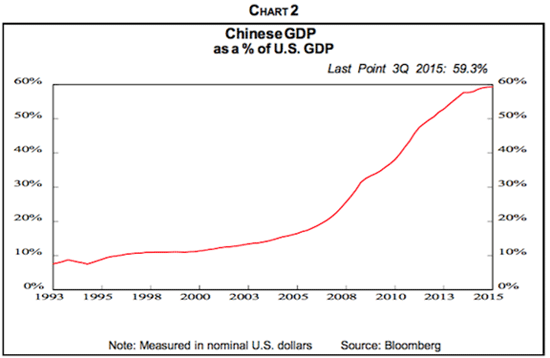
Reveling in Success
The Chinese revel in that success. They view themselves as the world’s superior society, and have chafed at being under European thumbs in the 1800s and Japanese hegemony in the last century. For years, the Chinese have lusted to be big players on the global stage, and have her yuan currency recognized by the International Monetary Fund as a reserve currency, right up there with the dollar, euro, yen and sterling. It finally was late last year.
They also have enjoyed the widespread conviction in the West that, with recent sluggish growth in North America and Europe, China was inheriting the mantle of global economic leadership. Indeed, many observers in and out of China believed that growth there would spill over to the West and spur gains in North America and Europe.
Leadership Direction
In fact, however, economic leadership has been the reverse. Like virtually all developing economies, China’s has been driven by exports that directly or indirectly are sold to North America and Europe. And those imports by the West are fundamentally curtailed by sluggish overall economic growth, the result of deleveraging, the working off of excess debt built up in the exuberant 1980s and 1990s. Annual Chinese export growth dropped from 20% to 30% in the 2000s to a 7% decline last November from a year earlier (Chart 3).
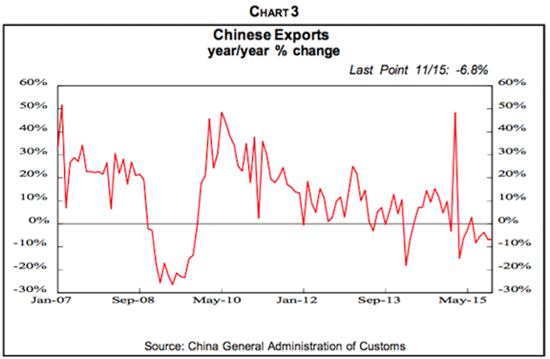
In the U.S., real GDP growth has averaged only 2.2% since the recovery commenced in mid-2009, about half the rebound rate you’d expect after the deepest recession since the 1930s. Similarly, the eurozone has limped along at a 0.7% rate with another recession in 2011-2013 following the 2007-2009 global Great Recession while Japan’s real GDP has averaged 0.9% with three more declines of a least two consecutive quarters since 2009.
Globalization
Also, globalization the transfer of manufacturing and other production from the West to China and other emerging economies is largely completed, curbing that source of emerging economy advance. U.S. factory output as a share of GDP skidded from 17% in 1997 to 12% in 2009, but then leveled off when just about all the production that could be moved overseas was offshored (Chart 4).

The resulting weakness in the Chinese economy, however, was masked until recently by massive housing, capital spending and infrastructure investment. But the residues are excess capacity, ghost cities and total corporate and government debt that leaped from 160% in 2004 to 232% in 2014. Also, China’s huge total economic size covered up its still-underdeveloped status. Even with the explosive growth in the past several decades, Chinese GDP per capita in 2014 was $7,590, or just 14% of America’s (Chart 5).
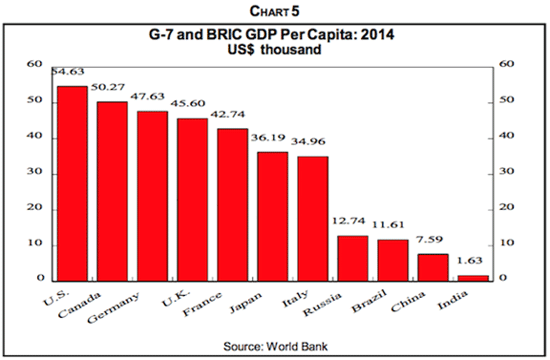
Chinese leaders want to shift to a domestic-led economy driven by consumer spending and services, but whenever overall growth flags, they resort to the same old, same old infrastructure spending. So the result is even more excess capacity and more political and economic power for the inefficient State-Owned Enterprises. And officials merge them rather than allow them to fail. At the same time, private firms are starved for capital.
These actions not only reveal Beijing’s distrust of free markets but also its reluctance to address the trade-off between heavy industry pollution generation and economic growth. Meanwhile, consumer spending in China is almost off the chart compared to G-7 and even BRIC economies. It’s 34% of GDP in China vs. 59% in India, 60% in Italy and 68% in the U.S. (Chart 6).
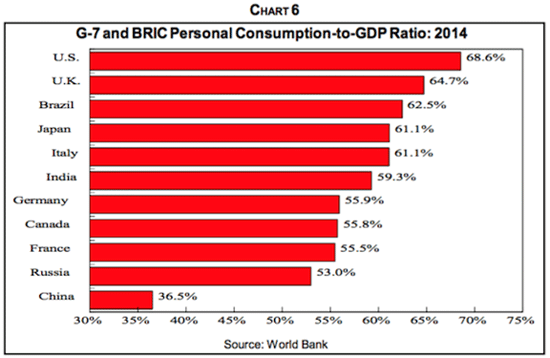
Financial Pygmy
China is a giant in global manufacturing, but an amateurish pygmy on the worldwide financial stage. That was evident last summer when the government clumsily intervened to arrest the one-third drop in Chinese stocks after hyping equities as the way to recapitalize debt-laden SOEs (Chart 7).

Margin selling was prohibited, brokers and state-owned enterprises ordered to buy stocks and trading halted as share prices plummeted. More recently, institutions are only allowed to sell 1% of their stock positions, and then after three weeks notice. As scared investors traded yuan for dollars to ship overseas (Chart 8), Chinese foreign currency reserves fell $600 billion since last August to $3.3 trillion at year’s end. The removal of those yuan also shrinks the domestic money supply.
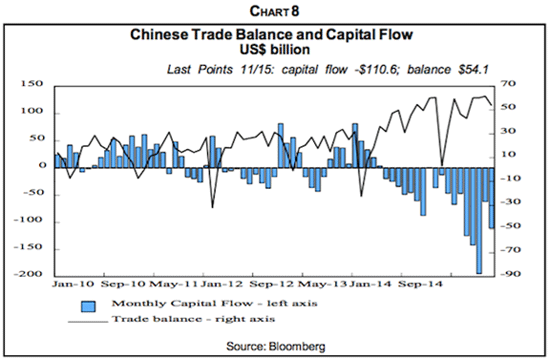
Then followed currency devaluation as China attempts to spur exports to revive economic growth, which is probably running only half the official 6.9% rate (Chart 1). Additional devaluation is likely but more subtly to avoid further massive flight from the yuan (Chart 8). Export subsidies, internal devaluation through wage and price cuts, and a shift from the dollar to a trade-weighted basket of currencies are all active possibilities. Notice (Chart 9) that since 2005, that the yuan has risen 26% vs. the dollar, but 40% against the trade weighted basket of currencies. This leaves China at a 14% currency disadvantage compared with her trading partners.
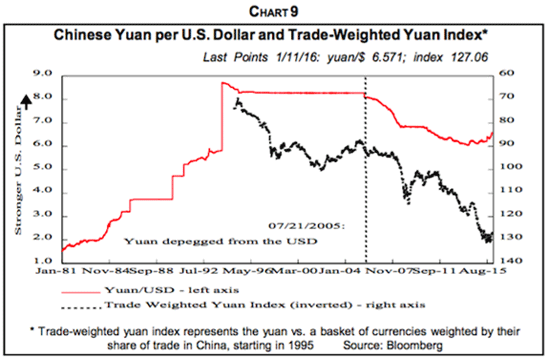
Chinese officials say they want to move toward free markets but still insist on top-down control a very difficult combination to manage. Following the market turmoil touched off by the 1.9% yuan devaluation last August 11, the central bank the People’s Bank of China said it would set the yuan’s daily fix, around which it is allowed to fluctuate 2%, in line with the previous day’s closing level. That would give markets more sway over its value than the previous administered rates.
But with this new mechanism, official attempts to weaken the yuan to spur exports and economic growth in early January resulted in a stampede out of the currency. So the PBOC abandoned that step toward a free market for the yuan and ordered the government-controlled large banks to buy yuan to support the currency. The daily currency fix is back to being a black box. This reality was driven home by the recent statement by a senior Chinese economic official that China has plenty of ammunition to defeat attacks on her currency. “Attempts to sell short the yuan will not succeed,” he said. “The expectations of markets can be changed.” Translation: We have ways!
Recently, China security regulators instituted a circuit-breaker system to protect investors from massive sell-offs by suspending trading after meaningful market losses. But reflecting disdain for stocks inherent volatility, they set the collar too narrow, at only 7%.
So it backfired after the limit was hit twice in the system’s first four days and was suspended on January 7, only 29 minutes into the trading day. Skittish retail investors that dominate the Chinese market dumped stocks in anticipation of an early market closing, and precipitated their expectation. That was the shortest trading day in the Chinese stock market’s 25 years.
Not Dead
China won’t shrivel up and die, but will be a much less important actor on the global stage, as she shifts her orientation from commodity-munching exports, housing and infrastructure to consumer spending and services. The same was true of Japan starting in the early 1990s. Before that, many Americans though they’d soon be working for Japanese companies or run out of business by then. The Japanese were buying Iowa farmland, Pebble Beach and Rockefeller Center with gay abandon. But at the end of the 1980s, Japan’s stock market bubble collapsed (Chart 10) as did overblown house prices (Chart 11), and the economy fell into the still-ongoing era of tiny 1.1% real GDP growth and deflation (Chart 12).

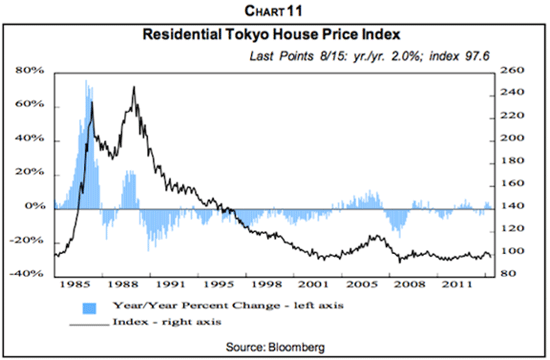
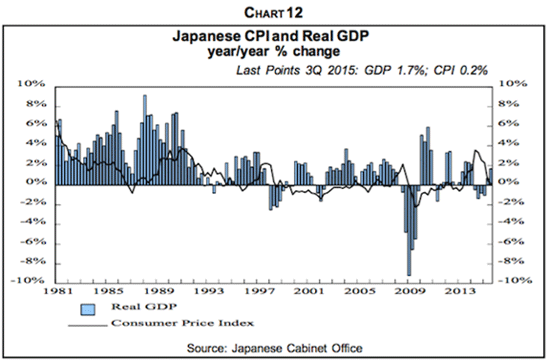
Similarly, Chinese stocks went off the cliff last summer (Chart 7) and residential housing activity has collapsed (Chart 13). And just as Japan’s delay in cleaning up the busted zombie banks in the 1990s and 2000s contributed to business malaise, China’s delay in restructuring the SOEs will likely have similar repercussions.
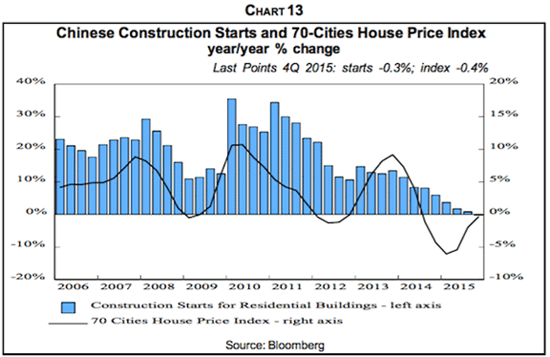
Furthermore, China has yet to address the trade-off between pollution and economic growth that Japan did earlier. We remember being in Tokyo in the 1980s when pollution was so thick that even on cloudless days, you still couldn’t see the sun.
Another parallel that’s slowing economic growth, in both China and Japan, is the declining work force. Population in Japan is actually falling (Chart 14) as the sub-replacement fertility rate combines with the longest G-7 life expectancy (Chart 15). When the effects of no legal immigration into Japan are included, the proportion of the total population of working-age is headed for the lowest level among major countries (Chart 16).
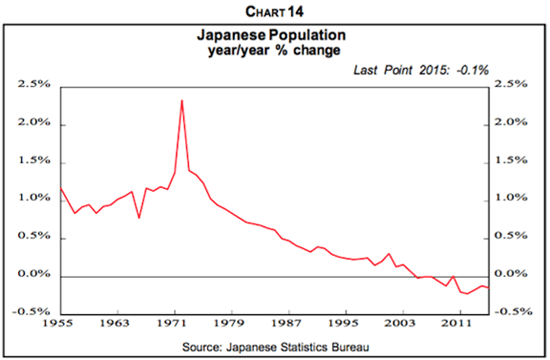
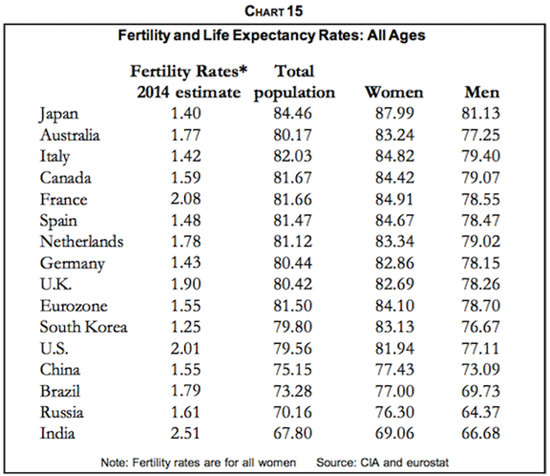

Old Before Rich
In China, the earlier one child per couple policy is slashing the number of prime new labor force entrants, the 15-to-24-year-olds (Chart 17), while the supply of rural labor to move to cities and man factories has run out. Unlike Japan, however, China is getting old before it gets rich.
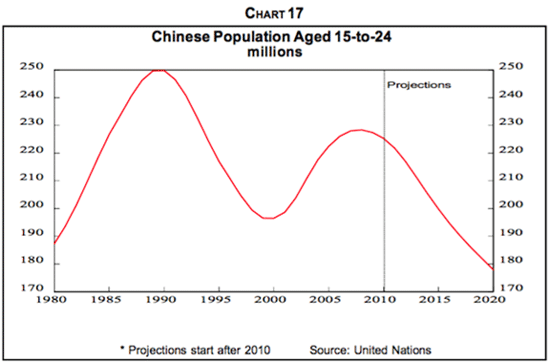
The earlier massive buying of foreign assets by Japan was aimed in part at securing raw materials for her manufacturing juggernaut and markets for its output. In retrospect, however, it was also due to a dearth of growth-spurring investment opportunities at home. Ditto for China, which is now buying foreign real estate and other assets in huge quantities.
We keep extensive files of newspaper clippings and other information to help in writing our own reports. In the 1980s, the Japan files were measured in feet but our China files took only an inch or two. Today, it’s the reverse. Still, as shock-and-awe over China recedes in future years, along with China’s significance on the world stage, we expect our files on China to shrink back to Japan’s size.
Subscribe to GARY SHILLING’S INSIGHT and you’ll receive:
13 Monthly Reports (25-35 pages) via E-Mail for $335 ($375 via regular mail)
THAT’S 13 REPORTS FOR THE PRICE OF 12!
Your subscription will start with the January 2016 INSIGHT report that includes Gary Shilling’s long-term outlook, his 2016 investment themes, and his views on whether slow economic growth is here to stay.
TO SUBSCRIBE, CALL US at 1-888-346-7444 or 973-467-0070. Or E-MAIL US at insight@agaryshilling.com.
BE SURE TO MENTION OUTSIDE THE BOX to get your 13-month subscription.
(THIS OFFER IS AVAILABLE ONLY TO NEW SUBSCRIBERS.)












